Last updated on
Metal roofing offers a durable and energy-efficient solution for homeowners, and this article provides an understanding of its benefits, installation, maintenance, and cost considerations.
Key takeaways:
- Aluminum roofs: lightweight, corrosion-resistant, energy-efficient, recyclable.
- Copper roofs: unique aesthetic, long-lasting, low maintenance, environmentally friendly.
- Steel roofs: galvanized, galvalume, weathering steel options, protection against corrosion, suitability to environmental conditions.
- Standing seam metal roofs: sleek, modern appearance, weather-tight seal, minimize water infiltration.
- Metal shingles: mimic traditional materials, textured, dimensional look, superior performance in harsh weather.
Metal Roof Material Types

Aluminum roofs are lightweight and resistant to corrosion, making them ideal for coastal regions. They reflect sunlight effectively, reducing cooling costs in hot climates.
Copper roofing offers a unique aesthetic with a natural patina that develops over time. It’s extremely long-lived and can last over a century with proper maintenance, though it is typically more expensive than other metals.
Steel, often galvanized or coated with a layer of zinc or a mixture of zinc and aluminum for added rust resistance, is one of the most commonly used materials for metal roofing. It’s stronger and more impact-resistant than aluminum, making it a good choice for areas with severe weather conditions. Steel can also be finished with a variety of coatings to mimic the look of other materials, such as wood or slate, and to enhance its protective qualities.
Aluminum
Aluminum roofing offers distinct advantages for homeowners and contractors. Its lightweight nature makes it easier to handle and install, a considerable benefit during construction or when reinforcing older structures that cannot support heavier materials. This attribute also contributes to reduced shipping costs.
Additionally, aluminum’s natural resistance to corrosion and rust makes it an ideal choice for coastal areas where salt spray is a concern. Over time, it forms a protective layer known as aluminum oxide, which further enhances its durability, making it a long-term solution for roofing.
Energy efficiency is another strong point. The reflective qualities of the material can deflect sunlight, contributing to cooler indoor temperatures during hot months. Homeowners may see a reduction in their cooling costs due to this effect.
Recyclability is a key environmental benefit of aluminum. It can be recycled repeatedly without losing quality, which means that aluminum roofing can be both a sustainable choice and a contributor to a lower carbon footprint.
Copper
Copper offers a unique aesthetic that sets it apart from other metal roofing options, developing a beautiful patina over time that can add a historic or sophisticated look to a building. Its durability is unparalleled, often outlasting the very structure it covers, with lifespans that can exceed a century under proper conditions.
Unlike other metals, copper is naturally corrosion-resistant. This feature means that roofs made of copper do not require additional coatings, thus reducing maintenance efforts. Despite its higher upfront cost compared to other metal roofing materials, copper’s longevity and minimal upkeep can result in lower life-cycle costs.
Its lightweight nature also places less structural stress on buildings, making it a versatile choice for both new constructions and renovations. Moreover, copper is highly recyclable, which aligns well with sustainable building practices. When choosing copper roofing, consider the long-term value it brings through its endurance, timeless appeal, and environmental advantages.
Steel
Galvanized, galvalume, and weathering steel are the primary forms of steel used in metal roofing. Galvanized steel, coated with a layer of zinc, offers robust protection against corrosion and is one of the most commonly used materials due to its effectiveness and affordability. Galvalume steel receives a coating of a mixture of aluminum, zinc, and silicon, providing enhanced corrosion resistance and durability. This combination is particularly effective in protecting against rust and performance degradation.
For those looking for a more distinctive appearance, weathering steel, also known as Corten steel, develops a rust-like patina when exposed to the elements, while simultaneously forming a protective layer. This material is often used in architectural applications for its unique aesthetic, although it is not as commonly selected for residential roofing due to its potential to bleed rust onto other parts of the building.
It is crucial to match the type of steel with the environmental conditions of the area. Coastal regions, for instance, may require a different steel composition compared to areas with less humidity and salt in the air. Make sure to discuss these factors with your contractor to ensure that the chosen material will meet the longevity and durability expectations for the project.
Metal Roof Styles
Standing seam metal roofs feature long, vertical panels that lock together to form a weather-tight seal, offering a sleek, modern appearance that suits a variety of architectural styles. Their raised seams elevate the joints between panels above the level of the roofing itself, which minimizes the risk of water infiltration.
Alternatively, metal shingles present a different aesthetic, mimicking the look of traditional shingle materials, such as wood or slate, while still providing the resilience and longevity inherent to metal. They come in a range of textures, colors, and shapes, adding a dimensional look to a roof’s surface.
Both styles increase a home’s curb appeal while delivering superior performance against harsh weather conditions. They are adaptable for various roof slopes and configurations, thereby accommodating a wide array of design requirements. Whether you prefer the continuity of standing seam metal or the classic appearance of metal shingles, each option offers a unique combination of style and function.




